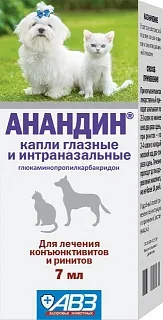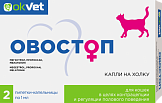Anandin eye drops and intranasal
Composition and pharmacological properties.
Eye drops and intranasal Anandin in 1 ml contain glucaminopropylcarbacridone (anandin) — 20 mg. It is used in the complex therapy of conjunctivitis and rhinitis of various etiologies in dogs and cats.
Glucaminopropylcarbacridone (anandin) belongs to the group of synthetic low-molecular-weight cytokine inducers, has anti-inflammatory and wound-healing effects, stimulates the production of endogenous interferon, increases the functional activity of T-lymphocytes and macrophages, activates the production of anti-inflammatory cytokines.
Indications for use.
Anandin eye drops and intranasal drops are used in the complex therapy of conjunctivitis and rhinitis of various etiologies in dogs and cats.
Contraindications
Contraindication to the use of the drug is an increased individual sensitivity of the animal to the components of the drug.
Dosage and administration procedure.
With conjunctivitis, the drug is instilled 2-3 drops behind the lower eyelid twice a day, with rhinitis-2-4 drops in each nasal passage two to three times a day. Treatment is carried out until the animal recovers, but not more than 14 days. The drops are compatible with other medicines and feed additives. You should avoid skipping the next dose of the drug, as this can lead to a decrease in therapeutic activity. In case of skipping one dose, the use of the drug is resumed at the same dose and according to the same scheme.
Side effects.
Side effects and complications when using the drug in accordance with the instructions, as a rule, are not observed.
In case of increased individual sensitivity to the active components of the drug or overdose, it should be washed off with water and detergent and antihistamines and symptomatic agents should be prescribed to the animal.
Special studies on pregnant and lactating animals were not conducted. The possibility of using drops of ocular and intranasal Anandin to females during pregnancy and feeding the offspring is determined by the attending physician based on the assessment of the ratio of benefit to possible risk of using the drug .
Storage.
The shelf life of the drug, subject to storage conditions, is 2 years from the date of production. Store the medicinal product in the closed packaging of the manufacturer in a place protected from direct sunlight, separate from food and feed, at a temperature from 0 °C to 25 °C.

The information provided in this catalog is for reference only. There may be some changes in the characteristics, packaging and packaging of products.
AVZ reserves the right to make such changes without notice. You can get full information about the updated products from your personal manager or your nearest AVZ dealer.
All drugs for veterinary use from this catalog may be contraindicated and when using it is necessary to familiarize yourself with the Instructions for Use.














